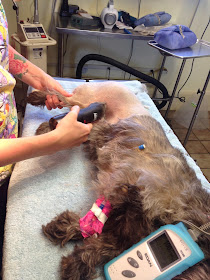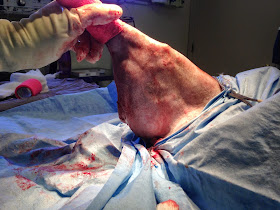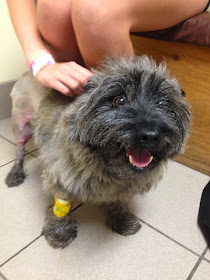 |
| This dog was brought in for limping. Her foot hurt so badly she refused to walk on it. Can you see the bruise on her pad? |
There are a few conditions that are relatively simple, benign and resolve quickly but often present as a dog who refuses to bear weight on the leg.
For any dog who is either lame, or worst yet, carrying a limb, the best place to start is with a calm, relaxed, slow methodical hands and eyes on 'every-tiny-inch of the leg' approach. I see a whole lot of lame dogs, and I thought it might be helpful if I explained how I approach these cases.
Here is how I approach the pet who presents for "lameness."
When I am trying to determine the cause of a limp or lameness I always start with watching the pet ambulate. The best place to do this is in a closed, quiet, open room with as little furniture or hiding places as possible. In the exam room I will stand at the far corner and ask the owner to place the pet on the floor and calmly walk over to me as they coax the pet to follow. The pet will in most cases follow their mom or dad if they and this which allows me a few moments to watch them walk.
Analyze the walk
How much weight will they put on the leg? I scale lameness out of 1 to 5. 0 being normal, 5 indicating they will not put the foot on the floor.
How much do the flex or extend at the joints? I want to see a good range of motion in every joint from the top to the bottom.
There are many subtle clues to a walking pet. They give me some hints about the bones, joints, muscles, and the nerves. When it comes to getting what you pay for an experienced eye from your vet can help your pet in innumerable ways. When a client calls me at 10 pm wondering whether their pet needs to go to the ER or whether they can wait until we are open I always tell them to send me a video. I can usually tell them with 30 seconds of a good walking clip.
The Physical Exam
I then try to take an educated guess where I think the problem is. If I think it is in the toe I look at the opposite leg from the shoulder down. Then I examine the lame leg from the shoulder down. Your hands do much of the work in veterinary medicine. We palpate for muscle size, lymph node size and number, bone pain and irregularities, joint swelling and range of motion, muscle size and sensitivity, etc. I try to palpate every muscle belly, every nook and cranny, and every anatomical structure in the leg. I also have to remember that some lameness results from an injury to the spinal cord.
When I think I have found the source of pain, (remember we are lame usually because we are painful) I then focus on what the root cause is.
Here's a tip from experience; For almost every single lameness exam, after I have watched the pet walking, I warn the parent that I am probably going to have to muzzle their pet. I know that people hate muzzles, for some reason they think they are cruel punishment devices?, or that it is a reflection of their parenting skills (sometimes there is a hint of truth to this), but I am looking for clues for the source of the discomfort/pain and I am asking the pet to respond. We all respond to pain differently, and when I am restraining them prohibiting their ability to flee that only leaves them with one other option. And so, I expect that in almost all cases the pet will respond with their best defense, a snip, a bit, a growl, and a harsh warning to back my inquisitive annoying self off. I don't blame them. I would bite the hand that hurts me too!
Remember when it comes to assessing the leg for lameness you have a cheat sheet. Use the other leg/foot to help identify differences. Subtle clues like;
After a topical anesthetic was applied we quickly and pain-freely removed her broken toe nail.
Here is how I approach the pet who presents for "lameness."
When I am trying to determine the cause of a limp or lameness I always start with watching the pet ambulate. The best place to do this is in a closed, quiet, open room with as little furniture or hiding places as possible. In the exam room I will stand at the far corner and ask the owner to place the pet on the floor and calmly walk over to me as they coax the pet to follow. The pet will in most cases follow their mom or dad if they and this which allows me a few moments to watch them walk.
Analyze the walk
How much weight will they put on the leg? I scale lameness out of 1 to 5. 0 being normal, 5 indicating they will not put the foot on the floor.
 |
| This is my pup Jekyll. Grade 5, yesterday. I corrected his cruciate rupture a week ago, on the other side. Time for this one to be done is now ASAP. And you think your dog has bad luck? |
There are many subtle clues to a walking pet. They give me some hints about the bones, joints, muscles, and the nerves. When it comes to getting what you pay for an experienced eye from your vet can help your pet in innumerable ways. When a client calls me at 10 pm wondering whether their pet needs to go to the ER or whether they can wait until we are open I always tell them to send me a video. I can usually tell them with 30 seconds of a good walking clip.
The Physical Exam
I then try to take an educated guess where I think the problem is. If I think it is in the toe I look at the opposite leg from the shoulder down. Then I examine the lame leg from the shoulder down. Your hands do much of the work in veterinary medicine. We palpate for muscle size, lymph node size and number, bone pain and irregularities, joint swelling and range of motion, muscle size and sensitivity, etc. I try to palpate every muscle belly, every nook and cranny, and every anatomical structure in the leg. I also have to remember that some lameness results from an injury to the spinal cord.
When I think I have found the source of pain, (remember we are lame usually because we are painful) I then focus on what the root cause is.
Here's a tip from experience; For almost every single lameness exam, after I have watched the pet walking, I warn the parent that I am probably going to have to muzzle their pet. I know that people hate muzzles, for some reason they think they are cruel punishment devices?, or that it is a reflection of their parenting skills (sometimes there is a hint of truth to this), but I am looking for clues for the source of the discomfort/pain and I am asking the pet to respond. We all respond to pain differently, and when I am restraining them prohibiting their ability to flee that only leaves them with one other option. And so, I expect that in almost all cases the pet will respond with their best defense, a snip, a bit, a growl, and a harsh warning to back my inquisitive annoying self off. I don't blame them. I would bite the hand that hurts me too!
Remember when it comes to assessing the leg for lameness you have a cheat sheet. Use the other leg/foot to help identify differences. Subtle clues like;
- How much weight is being placed on the foot (a flatter foot has more weight on it).
- How long the toe nails are. Indicates how the foot is used.
- How the toes touch the ground. Is the pet reluctant or unable to place the foot correctly.
- What is the muscle mass from one leg to the other. A loss of muscle mass indicates dis-use, and more atrophy indicates either severity or chronicity.
- Is there saliva staining. A black/rust colored foot is a clue the pet is trying to tell you something.
 |
| My other pup, Charlie, who licks between his toes on his left foot. |
 |
| Can you see the difference between the two feet? The hair on the right foot is white, on the left its brown, from saliva staining. |
 |
| This is Peanut. Her mom noticed that she was intermittently carrying her back left leg. Can you spot her boo-boo? |
 |
| Peanut has a blister between her middle two toes. For those of us who suffer walking around in a new pair of high heels we know how painful this is! |
This pup was at being watched by a relative while her family was away on vacation. They are familiar with her seasonal allergies an have learned how to best manage them at home.The pet sitter didn't recognize that her allergies were flaring up. When her parents returned they were shocked to see how itchy, painful, and discolored she was.
 |
| Ellie Mae hands me a sore foot. |
 |
| Ellie Mae's feet are brown, the toenails are dark brown at the base. She has been sitting around all week licking her paws. They ITCH! |
The last place to look is the toenails. A broken toenail can be incredibly bothersome and most pets will lick at it incessantly and limp on the foot until the nail falls off or is removed.
 |
| Lorelei's nail is almost broken off at the base of the nail. Every time she tries to stand on the foot the raw skin and jagged nail hurts her sensitive toe. |
 |
| Quik-Stop to stop the bleeding. |
 |
| Another happy, pain-free, limp-free customer. |
My point is that limping pets arrive for a multitude of reasons. A good exam, a thorough history, a watchful eye, adept hands, and maybe even an x-ray or two, and most of our limping pets can be treated quickly, easily, and alleviated of their discomfort. Most limping pets are not an emergency. But the identification of the root cause, and a plan to assist the pet parents in understanding the consequences of waiting, and helping them to curb it in the future all help to find a quick end to a common presenting complaint.
The Treatment Plan
This should always be tailored to the patient and should address the following items;
How do we alleviate the pain?
How much time should it take for the lameness to resolve?
When should the problem be re-checked?
What are signs of the problem not resolving?
And, one of the most important, and frequently over looked parts of the treatment pan is;
How can we prevent it from happening again? Understanding how this occurred and how you can prevent it will hopefully keep your pet pain free and out of the vets office. (Almost ALL of the toe nail problems occur because people are not keeping them trimmed).
If you have a question about your pet, or want to share your personal pet experiences with a community of pet loving people please visit us at Pawbly.com. Pawbly is always free to use and we welcome your questions and comments.
You can also find me at the clinic, Jarrettsville Vet, in beautiful Jarrettsville Maryland, on Facebook, and on Twitter @FreePetAdvice.













































